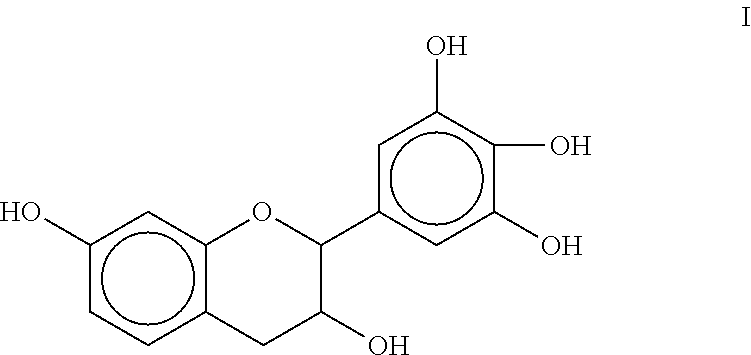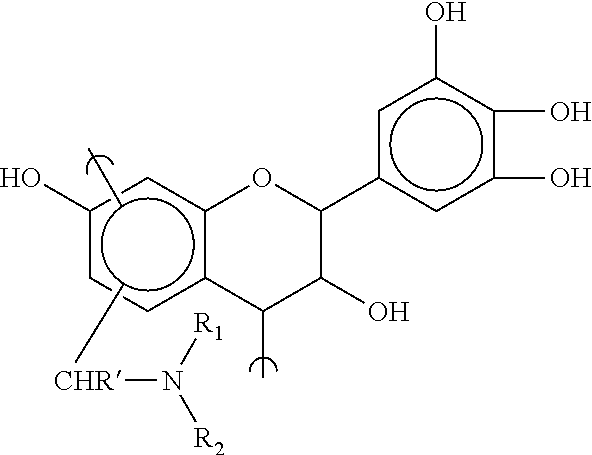Methods of removing microbes from surfaces
a technology of microorganisms and surfaces, applied in the direction of biocide, plant/algae/fungi/lichens, biocide, etc., can solve the problems of reducing the efficiency of the industrial process in question, reducing the heat exchange efficiency, and affecting product quality, so as to achieve low dosage feed rate and good compatibility with the scale control agent in the system
- Summary
- Abstract
- Description
- Claims
- Application Information
AI Technical Summary
Benefits of technology
Problems solved by technology
Method used
Image
Examples
example 1
[0029]In order to demonstrate the efficacy of the tannin reaction products in inhibiting the growth of biofilms, microplate assay tests were undertaken on pseudomonas aeruginosa bacteria. The pseudomonas aeruginosa biofilms were grown in 96 well plates overnight and treated with the candidate treatments in 5 ppm, 10 ppm, 15 ppm and 30 ppm (actives) treatment amounts. Results are shown in Tables 1.1 and 1.2.
TABLE 1.1Pseudomonas Aeruginosa Biofilm RemovalTreatment5 ppm10 ppm15 ppm30 ppmC-137.04%32.89%25.05%40.39%C-234.56%38.25%50.13%52.68%C-30.00%31.56%58.21%76.60%Ex-A112.70%45.15%62.71%72.11%C-428.39%39.15%70.32%86.51%C-1 = (ethylene oxide (EO) / propylene oxide (PO)) polymerC-2 = trimethyl hexanoic acid modified EO / PO polymerC-3 = polyethyleneimineEx-A1 = ethanolamine / formaldehyde / tannin Mannich reaction productC-4 = AETAC / tannin copolymer having cationic charge density of 57.5% by weight; Mw ≈ 50,000-70,000 Daltons. AETAC is acryloxyethyl trimethylammonium chloride
TABLE 1.2Treatment(...
example 2
[0030]Compatibility tests were undertaken to assess the compatibility of candidate biofilm control agents with a well-known anionic scale control agent (SCA) in a simulated cooling water system. Compatibility was reviewed from the viewpoint of the treatment's ability to maintain the SCA performance in solution without substantial precipitation of the SCA. The SCA was a well-known acrylic acid anionic copolymer SCA, namely acrylic acid / allylhydroxypropyl sulfonate ether copolymer. (See U.S. Pat. No. 4,895,663, which disclosure is incorporated by reference herein in its entirety). In this Example, the test water shown in Table 2.1 was maintained at 70° C. After 18 hours, the water was filtered by 0.22 micron membrane and the residual phosphate in the filtrate was measured. Accordingly the PO4 deposition inhibition rate was calculated.
TABLE 2.1Test water compositionPH8.2Calcium (ppm as CaCO3)400Magnesium (ppm as CaCO3)100NaHCO3 (ppm as CaCO3)35Phosphate (ppm as PO4)8SCA active(ppm)15Te...
PUM
 Login to View More
Login to View More Abstract
Description
Claims
Application Information
 Login to View More
Login to View More - R&D
- Intellectual Property
- Life Sciences
- Materials
- Tech Scout
- Unparalleled Data Quality
- Higher Quality Content
- 60% Fewer Hallucinations
Browse by: Latest US Patents, China's latest patents, Technical Efficacy Thesaurus, Application Domain, Technology Topic, Popular Technical Reports.
© 2025 PatSnap. All rights reserved.Legal|Privacy policy|Modern Slavery Act Transparency Statement|Sitemap|About US| Contact US: help@patsnap.com


